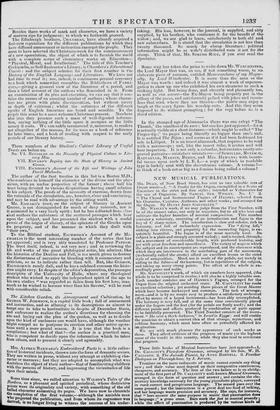NEW MUSICAL PUBLICATIONS.
Ma. DEAN, of New Bond Street, has sent us two valuable sets of Organ music-1. "A Studio for the Organ, exemplified in a Series of Exercises in the strict and free styles ; intended as Voluntaries for the use of Organists. By SAMUEL SEW. WESLEY. No. I." 2. " The Choral and Instrumental Fugues of HANDEL, selected from his Oratorios, Cantatas, Anthems, and other works; and arranged for the Organ. By HENRY JOHN GAUNTLETT." Mr. WESLEY'S work, if we may judge from the First Number, wilt be of the utmost value, riot only to organists, but to all who love and cultivate the higher branches of musical composition. 'This number. contains a voluntary, consisting of an introduction and fugue in the key of C sharp minor. The introduction is slow and solemn, rich in harmony, and full of melancholy expression. The " dying fall," sinking into silence, and preparing for the succeeding fugue, is ex- quisitely beautiful. The fugue is of the most masterly kind. Its- subject is a plain and strongly accented melody ; and is treated, through- out a movement of considerable length, with profound learning, and yet with great freedom and smoothness. The variety of ways in which the subject and its counterpoint are reproduced, and the closeness with. which they are interwoven in the concluding part of the movement,- (technically called the stretta) afford an excellent lesson in the strict style of composition. Much use is made of the pedals, not merely in adding to the fulness of the harmony, but in repetitions of the subject, and taking tip many strong points. The effect of the whole is ex- ceedingly grave and noble. Mr. GAUNTLETT'S work, of which six numbers have appeared, (the whole is to be comprised in twelve,) will also be a highly valuable one. Each number contains one of HANDEL'S Fugues, arranged for the Organ from the original orchestral score. M. GAUNTLETT has made an excellent selection ; yet avoiding those pieces of the Great Master which have become hackneyed and common. The task of arrange- ment—and it is by no means easy to produce a satisfactory orchestral' effect by means of a keyed instrument—has been ably accomplished._ The harmony is very full, and at the same time conveniently placed under the fingers and the feet (for the pedals are freely used); and the different points and effects produced by combination of parts appear to be faithfully preserved. The Third Number consists of the move- ment." He sent a thick darkness," in Israel in Egypt : and will enable the musician to obtain a correct idea of that strange, mysterious, and sublime harmony, which must have often so powerfully affected his imAgination. We see with much pleasure the appearance of such works as these. They afford evidence of the progress of music (in the highest sense of the word) in this country, while they also tend to accelerate that progress.


























 Previous page
Previous page